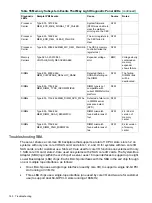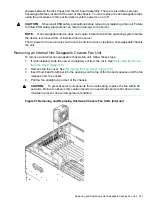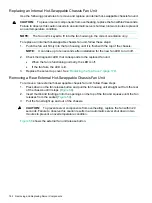
Server Interface (System Console)
All system console connections (VGA, USB, local RS-232 and iLO 2 MP LAN) are located on
the bulkhead of the core I/O board FRU at the rear of the chassis.
HP-UX uses the RS-232 serial text connection to a (dumb) terminal or terminal emulator software
running on a PC to control server operations locally.
HP-UX alternatively uses the iLO 2 MP LAN connection over a private network to control server
operations locally using telnet or SSH, and remotely over a public network through the web GUI.
Both the Windows and LINUX operating systems use the VGA (monitor) and USB (keyboard
and mouse) connections to control server operations locally.
Troubleshooting Tips
RS-232 connection: If a dumb terminal / PC running terminal emulation software is attached to
the iLO 2 MP “local” port and does not respond to a Control-B CR key sequence (and the terminal
is running 9600 baud, 8 data bits, is ONLINE, and so on), it is possible that the iLO 2 MP is not
operational / functional. See
“Management Subsystem (iLO 2 MP/BMC)” (page 167)
for the
following LED locations:
•
The iLO 2 MP’s Heartbeat LED
•
The BMC’s Heartbeat LED
Replace core I/O board FRU if both Heartbeat LEDs are not flashing green; suspect bulk power
supplies, or midplane board FRU, or I/O backplane board FRU if both Heartbeat LEDs are off.
LAN connections: See
“I/O Subsystem (SAS/SATA/SCSI/DVD/HDD/Core I/O)” (page 168)
for iLO
2 MP LAN LED states.
Environment
Ambient intake air temperature is often different from ambient room temperature; you should
measure the operating temperature and humidity directly in front of the cabinet cooling air intakes,
rather than measure only ambient room conditions.
Within the server, temperature sensors report chassis temperature to the BMC. The BMC controls
fan speed, based on this information.
Temperature sensors are found on the display panel, where a thermal sensor detects the ambient
room temperature. This sensor’s reading is the main parameter used to regulate fan speed, under
normal conditions
provides environmental specifications for the server:
Table 69 Environmental Specifications
Non-Operating
Range
Maximum Rate of
Change
Recommended
Operating Range
Operating Range
Parameter
-40 degrees to +70
degrees C
10 degrees C/hr.
with tape; 20
20-25 degrees C
(up to 5000 feet)
5-35 degrees C (up to
5000 feet)
Temperature
degrees C/hr.
without tape
30% per hour
noncondensing
40-60% at 35
degrees C
noncondensing
15-80% at 35 degrees
C noncondensing
Relative Humidity
Reporting Your Problems to Hewlett Packard Enterprise
Hewlett Packard Enterprise customer care will help you solve server problems and, if necessary,
initiate appropriate service procedures.
Support is available on the web and by phone.
172
Troubleshooting
















































